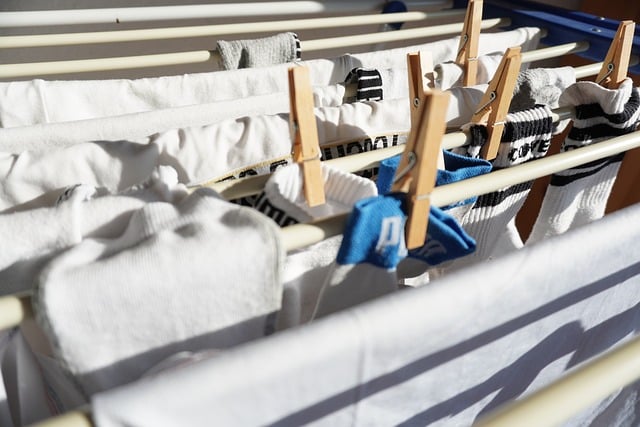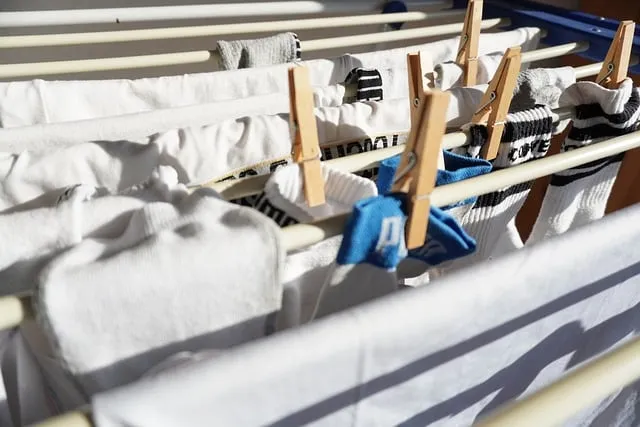How Can Proper Loading Techniques Improve Dryer Energy Efficiency?
Imagine your dryer as a well-oiled machine that’s ready to perform at its best. But if you overload it, it’s like stuffing a car’s trunk to the brim with bags. The engine has to work harder, and you’ll likely find your clothes still damp or needing extra cycles. This isn’t just inconvenient; it’s also a drain on your energy and wallet. On the flip side, underloading the dryer can be just as inefficient. A nearly empty drum means that energy is being wasted on drying just a few items.
So, what’s the sweet spot? Aim to load your dryer to about three-quarters full. This allows the dryer to tumble effectively, ensuring that hot air circulates evenly and dries your clothes more efficiently. Think of it like filling a pot with water. If you put in too much, it boils over; too little, and you’re wasting energy heating up more water than necessary.
Also, remember to clean the lint filter regularly. A clogged filter is like having a kink in a hose; it restricts airflow, forcing your dryer to work harder and use more energy. By keeping the filter clean and loading the dryer properly, you’re setting the stage for optimal performance. This not only saves you money but also extends the life of your dryer.
So, next time you toss your laundry in, think about the load and the filter. It’s a small adjustment that can lead to big savings and a more efficient appliance.
Unlocking Energy Savings: How Proper Dryer Loading Techniques Slash Utility Bills
Imagine your dryer as a crowded concert venue. If the space is packed too tight, the performance (or drying in this case) suffers. Similarly, overloading your dryer means clothes can’t tumble freely. This restricted airflow forces the dryer to work harder, leading to longer drying times and increased energy use. By giving your dryer enough room to breathe—loading it just halfway full—you allow for better air circulation, which means clothes dry faster and more efficiently.
And here’s a pro tip: don’t mix heavy and light items. Think of it like cooking a stew with ingredients that cook at different rates. If you toss in vegetables and meat, you’ll end up with unevenly cooked food. The same principle applies here. Heavy items like towels and lighter items like shirts should be dried in separate loads to ensure even drying. This not only saves energy but also extends the life of your clothes.
Also, remember to clean the lint trap before every load. A clogged lint trap is like trying to run a marathon with a parachute strapped to your back. It restricts airflow and makes the dryer work harder. By keeping the lint trap clean, you optimize airflow and efficiency, reducing drying time and saving energy.
So, the next time you toss clothes into the dryer, think about it as setting up a well-organized concert or cooking a perfectly balanced stew. Proper dryer loading might seem like a small tweak, but it’s a powerful way to cut down on those pesky utility bills.
Load Smart, Save Big: The Secret to Boosting Dryer Efficiency

First things first: Overloading is a major no-no. Picture stuffing a suitcase to the brim; the zippers barely close, and you’re left wrestling with it. That’s what happens when you overload your dryer. Clothes get bunched up, air circulation is restricted, and the dryer has to work overtime, which can lead to longer drying times and higher energy usage.
On the flip side, if you underload your dryer, you’re not optimizing its efficiency either. It’s like having a huge empty room with a tiny heater in the corner—it’s just not effective. To get it right, aim for a balanced load. Clothes should have enough room to tumble freely but not so much space that the dryer’s working too hard.
Using dryer balls or clean tennis balls can be a game-changer. These little wonders help separate items, allowing hot air to circulate better and reducing drying time. Plus, they’re eco-friendly and help soften your laundry naturally.
Let’s not forget about maintaining your dryer. Regularly cleaning the lint filter and ensuring the vents are clear can prevent blockages that make your dryer work harder than necessary. This simple upkeep can lead to significant savings on your energy bill and prolong the life of your appliance.
The Science of Dryer Loading: Optimize Your Appliance for Maximum Energy Efficiency
Imagine your dryer as a large spinning bowl. If you cram it with clothes like it’s a packed suitcase, the air can’t circulate properly. It’s like trying to mix a salad with too many ingredients in a tiny bowl—you end up with unevenly tossed greens. When clothes are packed too tightly, they don’t dry evenly, forcing the dryer to work harder and use more energy.

On the flip side, overloading your dryer can lead to wrinkled clothes and longer drying times, which means more energy consumption and increased wear and tear on the machine. You might think a full load saves energy, but in reality, it often leads to the opposite.
To optimize energy efficiency, try to load the dryer so that the drum is about two-thirds full. This balance allows the air to circulate freely, drying your clothes evenly and quickly. It’s like having just the right amount of ingredients to ensure a perfectly blended smoothie.
Also, remember to separate heavier items from lighter ones. Drying a thick towel with a delicate shirt can cause uneven drying and extra energy use. Just like mixing different-sized ingredients in a blender, it takes longer and uses more power.
So, next time you toss clothes into the dryer, think of it as setting the stage for an energy-efficient performance. Load wisely, and you’ll save time, energy, and maybe even a bit of cash!
Why Dryer Loading Matters: Expert Tips for Cutting Energy Consumption
Overloading your dryer is like stuffing a suitcase with too many clothes. It’s crammed, and the air can’t circulate properly. This means your clothes take forever to dry, leading your dryer to work overtime. And guess what? That extra effort uses more energy, which is reflected in your utility bills.
On the flip side, underloading isn’t the golden ticket either. A half-empty dryer is inefficient, using nearly as much energy for a small load as it would for a full one. Think of it like cooking a single burger on a huge grill. It’s wasteful and doesn’t make the best use of resources.
So, what’s the sweet spot? The trick is to load your dryer to about 75% capacity. This way, there’s enough room for air to circulate, but you’re still drying a decent amount of clothes in one go. This not only cuts down on drying time but also ensures your dryer operates more efficiently, saving you both time and energy.
For optimal results, give your clothes a shake before tossing them in. This helps to separate them, allowing hot air to flow more freely. It’s like giving your laundry a little room to breathe, which speeds up the drying process and reduces energy use.
Next time you’re about to start a load, keep these tips in mind. A well-loaded dryer isn’t just a happy appliance—it’s a money-saver, too.
From Overstuffed to Optimized: How Correct Loading Practices Improve Dryer Performance
Picture this: your dryer is like a busy freeway. When it’s jam-packed with too many vehicles (or clothes), everything slows down, and the ride gets bumpy. Similarly, cramming your dryer full of laundry doesn’t just make it harder to reach those tricky spots like sleeves and collars; it also forces the machine to work overtime. This extra strain can lead to uneven drying, and sometimes, clothes come out damp or wrinkled.
But here’s the twist—loading your dryer properly is like clearing up that freeway and letting the traffic flow smoothly. Space in the drum allows hot air to circulate freely around every garment, ensuring that each piece gets the attention it deserves. Think of it as giving your clothes their own personal space to dry out efficiently.
Also, don’t underestimate the power of sorting your laundry. Mixing heavy items like towels with lighter fabrics like t-shirts can create a lopsided load, making it difficult for the dryer to handle. By separating them, you ensure that each load dries evenly and quickly, saving time and energy in the process.
And let’s not forget about those dryer balls or tennis balls—adding these to your load can help prevent clumping, ensuring that air flows around each item. It’s like giving your dryer a little extra help to get the job done faster and more effectively.
Save Energy and Money: Proven Loading Techniques for Your Dryer
First off, avoid overloading your dryer. It might seem like a good idea to cram everything in to get it done faster, but this actually hampers the dryer’s performance. Think of it as trying to fit too many people into a tiny room; everyone ends up uncomfortable and things just don’t work as well. Clothes need room to tumble and get evenly dried, so give them the space they need.
On the flip side, underloading can be just as wasteful. Running a half-empty dryer is like driving a car for just one errand—it’s not efficient. Make sure you load your dryer to an optimal level. The rule of thumb? Fill it about three-quarters full, leaving enough room for air to circulate.
Also, remember to sort your laundry. Drying heavier items like towels and sheets with lighter clothes can lead to uneven drying. It’s like mixing up a party with different types of guests who have different needs. Dry similar items together to ensure everything dries evenly and reduces the need for multiple cycles.
Lastly, clean the lint filter before every load. A clogged filter is like having a bouncer at your party who’s not letting anyone in. A clean filter improves airflow, which makes drying faster and more energy-efficient.
The Impact of Proper Dryer Loading on Energy Use: What You Need to Know
First off, think of your dryer as a marathon runner. If you pack it too tightly, it struggles to move efficiently, just like a runner carrying a heavy backpack. When clothes are jam-packed, the dryer has to work harder and longer to dry them, which not only stretches your laundry time but also boosts your energy bills. By giving your dryer some breathing room, you’re essentially letting it run a smoother race, which translates to better energy efficiency.
But let’s get specific. When you overload your dryer, heat and air circulation are compromised. This means that your clothes don’t dry evenly, and you might find yourself running multiple cycles to get everything dry. It’s like trying to bake a cake with too much batter in a pan—it doesn’t cook evenly, and you end up wasting time and energy.
On the flip side, underloading your dryer isn’t a golden ticket either. A nearly empty dryer means the dryer’s drum spins too much for too few clothes, which can also lead to inefficiency and higher energy consumption per item. So, finding that sweet spot is key.
The trick is to load your dryer so there’s enough space for air to circulate freely. A good rule of thumb is to fill the drum about three-quarters full. This balance helps your dryer work efficiently, saving you energy and money.
So, next time you load up your dryer, remember: just like packing a suitcase efficiently can make your trip more pleasant, packing your dryer properly can keep your energy bills in check and your clothes in top shape.

